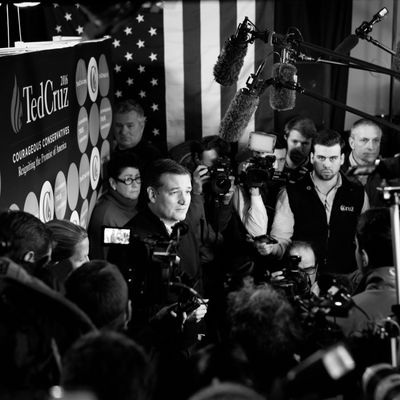
It’s hard to imagine finding space for yet more presidential-election coverage in your media diet, but here is Showtime’s The Circus: Inside the Greatest Political Show on Earth, which falls into a weird and appealing place in the middle of documentary, journalism, and reality TV. Analysts Mark Halperin and John Heilemann of Bloomberg Politics’ With All Due Respect are joined by political strategist Mark McKinnon as they report and comment on the 2016 presidential race. Each episode is structured around a single idea — the intense focus on the first primary in Iowa is dubbed “Tension City;” the New Hampshire primaries get framed as “The Winnowing.” Heilemann, Halperin, and McKinnon act as our narrators and talking-head experts, and like the film Mitt (which Heilemann and Halperin cite as an influence), their often intimate access to the candidates brings us the human moments and disguised chaos that take place outside the usual stump speeches.
Stylistically, though, The Circus plays out less like a documentary and more like a Sorkinized version of the 2016 presidential race. It capitalizes on the most appealing and most watchable aspects of many of Sorkin’s TV series, which are all about the borders between onstage and off-, and the permeable but enormous boundaries between the public persona and the real self. Many memorable Sorkin bits revolve around this idea — Abbey Bartlet cutting Jed’s tie moments before he goes onstage, the turkey falling on the Sports Night desk, speeches finished at the last moment, news anchors with no pants — and the Showtime series is chasing similar moments.
The Circus takes place on a giant stage, but it’s mostly interested in what the story looks like behind (and around, and before, and in the parking lot outside of) that stage. The camera frequently and purposely focuses on something dramatically off-center. In episode five, we see a shot of cameramen’s bodies crammed into the aisle of a small plane, all trying to get footage of John Kasich, who’s just won Kasich won the New Hampshire primary expectations game. Next we get a partially blocked shot of Kasich himself, but his face is on the severe lower left, and most of the frame is obscured by all the other cameras trying to film him. There’s footage of Bill Clinton’s speech at Wartburg College, but some of it is filmed through the preview screen of an intermediary camera. As Ted Cruz bows over a voter and shares a prayer, The Circus’s camera pans up to the cluster of boom mics looming above them.
So much of the series is like this. Halperin, Heilemann, and McKinnon film interviews with candidates and their staff from back hallways, inside buses, and as they depart from campaign stops. Where they can’t get inside-the-room access, they stand behind cute babies on rope lines, hoping to get a chance to ask a few questions. Occasionally, we do see straight-on, wide-shot footage of candidates centered on podiums, delivering speeches, but these are rarities, meant as punctuation marks to the longer, more nuanced story.
More often than not, The Circus uses these details in telling ways. In an early episode, McKinnon stands waiting for Hillary Clinton to exit an event, hoping to get a shot of her waving. As she leaves the building, McKinnon is ushered all the way to the parking lot by Clinton’s Secret Service detail, and The Circus’s camera zooms in dramatically to follow Clinton entering the back of a car parked mere feet from the doorway. “That’s the bubble,” McKinnon says, and when compared with the genial, open footage from within the Sanders campaign, the implication is clear.
There’s also a lot of Sorkin-style walking-and-talking, but for all the most appealing elements of Sorkin’s work that it mimics, The Circus is also prone to some of his pitfalls. When our white, male narrators gather together to explain things, there are lapses into pedantry and inside-baseball jargon. As the three discuss the phrase “the big mo’”at repetitive length, you can almost hear a post-Sorkin-era Josh Lyman crowing delightedly, “We’ve got the big MO!” Whereas the behind-the-scenes access feels fresh and novel, too often the commentary does not.
The bigger concern for The Circus, however, is that it’s so closely tied to the week’s events. This means there’s not much incentive to rewatch or discover older episodes, and it limits the show’s ability to push for a broader understanding of the election process. It’s hard for The Circus to say, “And that’s the lesson we draw from New Hampshire,” when they have no way of knowing what it is yet.
Nevertheless, it’s still often funny, revealing, and eminently entertaining. This is because, as Sorkin well knows, backstages are inherently fascinating. Especially on a stage this significant, there’s a persistent, nagging sense that somewhere, there’s a green room where the real stuff is happening. The Circus’s camera is our sneaky stand-in, granting us entrance to at least a few of those off-limits spaces. And there are moments — like the scene outside the Trump rally, or a moment with a small boy enthusiastically phone-banking for Hillary — that feel like glimmers of a much bigger, more populist, and even more appealing project, partially obscured through all the cameras and crowds.


